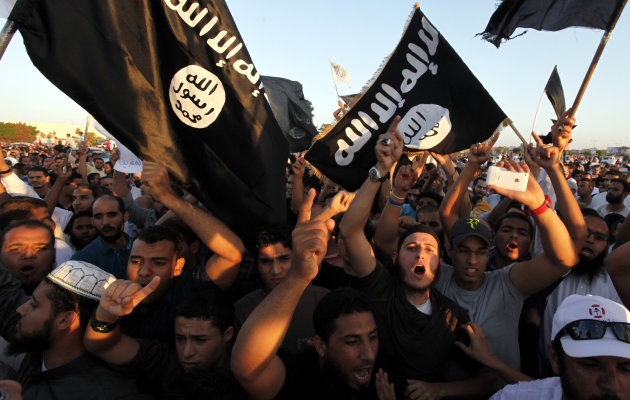 WASHINGTON (AP) — The heavily armed extremists who laid siege to the U.S. Consulate in Libya
used military-style tactics that may have steered Americans toward a
waiting ambush, U.S. officials said Friday as they pieced together
details about how the compound was overrun.
WASHINGTON (AP) — The heavily armed extremists who laid siege to the U.S. Consulate in Libya
used military-style tactics that may have steered Americans toward a
waiting ambush, U.S. officials said Friday as they pieced together
details about how the compound was overrun.
U.S. intelligence
indicates that 50 or more people, many of them masked, were responsible
for the Sept. 11 assault on the U.S. diplomatic mission in Benghazi.
Gun trucks provided added firepower. The attackers set up a perimeter,
controlling access in and out of the compound. A first wave of attacks
sent the Americans fleeing to a fallback building, where a second group
of extremists beset them with precise mortar fire.
Intelligence
reports were still coming in, but officials told The Associated Press
that what may have initially seemed like a protest over an anti-Islam
movie that had spun out of control now showed the hallmarks of a more
sophisticated operation.
In a
country coming off a civil war, a level of battlefield savvy does not
prove the attack on the compound was planned well in advance. How much
planning went into the operation and whether it could have been detected
or prevented remain unanswered questions, officials said.
The
attacks killed Ambassador Chris Stevens, diplomat Sean Smith and two
former Navy SEALs, who U.S. officials said were security officers
guarding diplomatic officials. Stevens was visiting Benghazi from
Tripoli to preside over the opening of an "American Space" cultural
center.
The officials spoke on
condition of anonymity because they were not authorized to discuss
intelligence reports. They stressed that even now authorities do not
have a clear understanding of exactly what happened in Benghazi. FBI
agents from New York and Washington were in Libya investigating the
attack.
Officials
have not singled out one responsible group, but have focused their
attention on Ansar al-Shariah, a Libyan militant group led by a former
detainee at the U.S. military-run prison in Guantanamo Bay, Cuba.
Whether the attack was premeditated carries both political and intelligence significance.
From an intelligence standpoint, the longer an operation was in the works ahead of the attack, the more the U.S. government will face scrutiny for not anticipating and preparing for it.
Politically, Republicans have accused President Barack Obama's administration of misreading the assault as an outgrowth of Middle East demonstrations over an American-made Internet video insulting the Islamic prophet Muhammad. They have also criticized the protection of the consulate, particularly since the attack fell on the anniversary of the Sept. 11, 2001, terrorist attacks, a date when authorities are normally on alert for attacks.
White House spokesman Jay Carney has said there was no evidence the attack was premeditated. Obama has said extremists used the protests as an excuse to attack.
A spontaneous protest that turns violent is harder to predict and respond to.
"The intelligence
agencies are still not confident enough to represent to us whether it
was planned in advance or taking the opportunity of a spontaneous
protest," Rep. Adam Schiff, D-Calif., said Friday.
Wanis al-Sharef, who was Libya's deputy interior minister until he was fired after the attacks, said a small group of lightly armed gunmen were the first to gather outside the compound. They were then joined by a crowd of civilians protesting the film. Finally, a larger group of heavily armed men arrived with gun vehicles and grenade launchers. That final group was responsible for the siege.
Ansar al-Shariah has repeatedly denied being any part of the attack, but eyewitnesses and security officials said the group's militiamen were among the gunmen who joined the demonstration outside the compound. The group claimed its fighters were only in the Benghazi area providing security at Jalaa Hospital. But that's more than three miles from the U.S. compound, which lies on the outskirts of the city in a rural area.
One witness
said he was detained by Ansar al-Shariah members during the protest
because he was taking pictures of one of their leaders.
About an hour after the assault began, American and Libyan forces retook control of the compound and brought everyone to the annex. Rescue teams headed their way.
Intelligence indicates the gunmen broke off into teams to block certain roads away from the compound, officials said. Whether that changed the route or otherwise influenced how the Americans moved through the streets remains unclear, but one U.S. official said the tactic was being looked at as an indication of battlefield strategy and sophistication.
As the
Americans waited to be rescued from the annex, that building came under
mortar fire. Mortars are short-range bombs that launch in high arcs.
Aiming them can be a matter of trial and error. But U.S. officials said
mortars were landing directly on the roof of the annex.
That, officials said, indicated an experienced fighter, a well-planned assault or both.



